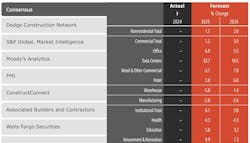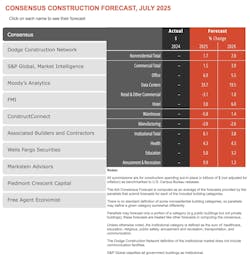Mid-year AIA Consensus Construction Forecast: No turnaround in sight for spending on nonresidential buildings
There is some good news and some bad news in the latest outlook for nonresidential construction spending on buildings, according to the latest AIA Consensus Construction Forecast.
First the good news: In spite of stubbornly high long-term interest rates, inflation rates stalled above the Federal Reserve Board’s target, falling consumer confidence scores, disappointing levels of home building activity, rising tariff rates for many inputs to construction, and construction labor shortages exacerbated by restrictive immigration policies, the outlook for the remainder of the year and into 2026 is largely unchanged from where it was at in the beginning of the year.
The bad news: The outlook for spending entering the year was very pessimistic.
The consensus is that overall spending on nonresidential buildings not adjusted for inflation will increase only 1.7% this year and grow very modestly to just 2.0% next year. The commercial sector outlook is about on par with the broader industry, with a projected 1.5% increase this year rising to 3.9% in 2026.
Spending on the construction of manufacturing facilities—the industry bright spot in recent years—is expected to decline 2.0% this year, with an additional decline of 2.6% next year. Institutional facilities are expected to be the strongest sector with projected gains of 6.1% this year and another 3.8% in 2026.
An economic slowdown is emerging
Entering the year, the economy was expected to grow about 2%, with the probability of a recession over the coming twelve months estimated at 22%, according to the Wall Street Journal’s quarterly economic forecasting survey in January. However, since then, the outlook for the year has deteriorated. There is a growing list of threats to the economy, including tariffs, labor market implications of federal immigration policy, and federal job losses and spending cuts. The seriousness of these threats was reinforced by a negative GDP reading in the first quarter, even though the downturn was mostly driven by a surge in imports to beat the tariffs.
Ever-changing tariff policy has created unusually high levels of uncertainty across the economy. Not knowing what products will cost in the future, whether they will be available, how these changes might affect their supply chain, and whether they will provoke a trade war with the exporting countries are all questions that the AEC industry is asking before proceeding with planned projects.
A current concern is the extent to which tariffs are inflationary. With a few exceptions to date, consumer prices and producer prices have not increased much with the imposition and threatened imposition of tariffs. While this may change, recent research published by the National Bureau of Economic Research concludes that transitory tariffs are neither inflationary nor contractionary (generating an economic downturn). This suggests that if current tariffs are a negotiating mechanism that may be lowered or eliminated in the near future, they may not be a major headwind to the economy.

